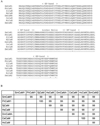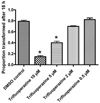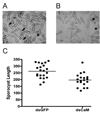Cloning and functional characterization of two calmodulin genes during larval development in the parasitic flatworm Schistosoma mansoni
- PMID: 21348610
- PMCID: PMC3666858
- DOI: 10.1645/GE-2586.1
Cloning and functional characterization of two calmodulin genes during larval development in the parasitic flatworm Schistosoma mansoni
Abstract
Schistosomiasis is endemic in over 70 countries, in which more than 200 million people are infected with the various schistosome species. Understanding the physiological processes underlying key developmental events could be useful in developing novel chemotherapeutic reagents or infection intervention strategies. Calmodulin is a small, calcium-sensing protein found in all eukaryotes and, although the protein has been previously identified in various Schistosoma mansoni stages and implicated in egg hatching and miracidia transformation, few molecular and functional data are available for this essential protein. Herein, we report the molecular cloning, expression, and functional characterization of calmodulin in the miracidia and primary sporocyst stages of S. mansoni. Two transcripts, SmCaM1 and SmCaM2, were cloned and sequenced, and a recombinant SmCaM1 protein was expressed in Escherichia coli and used to generate anti-CaM antibodies. The 2 protein sequences were highly conserved when compared to other model organisms. The alignment of the predicted proteins of both SmCaM1 and SmCaM2 exhibited 99% identity to each other and 97-98% identity with mammalian calmodulins. Analysis of steady-state transcript abundance indicate that the 2 calmodulin transcripts differ in their stage-associated expression patterns, although the CaM protein isotype appears to be constitutively expressed during early larval development. Application of RNAi to larval parasites results in a "stunted growth" phenotype in sporocysts with 30 and 35% reduction in transcript abundance for SmCaM1 and SmCaM2, respectively, and a corresponding 35% reduction in protein level after incubation in double-stranded RNA. Differential expression of CaM transcripts during early larval development and a growth defect-inducing effect associated with partial transcript and protein inhibition as a result of RNAi suggest a potentially important role of calmodulin during early larval development.
Figures








Similar articles
-
Potential role of a CD36-like class B scavenger receptor in the binding of modified low-density lipoprotein (acLDL) to the tegumental surface of Schistosoma mansoni sporocysts.Mol Biochem Parasitol. 2006 Apr;146(2):219-30. doi: 10.1016/j.molbiopara.2005.12.010. Epub 2006 Jan 6. Mol Biochem Parasitol. 2006. PMID: 16427708
-
Calmodulins from Schistosoma mansoni: Biochemical analysis and interaction with IQ-motifs from voltage-gated calcium channels.Cell Calcium. 2018 Sep;74:1-13. doi: 10.1016/j.ceca.2018.05.006. Epub 2018 May 17. Cell Calcium. 2018. PMID: 29802931
-
Molecular and functional characterization of a putative PA28γ proteasome activator orthologue in Schistosoma mansoni.Mol Biochem Parasitol. 2013 May;189(1-2):14-25. doi: 10.1016/j.molbiopara.2013.04.003. Epub 2013 Apr 20. Mol Biochem Parasitol. 2013. PMID: 23611749 Free PMC article.
-
RNA interference targeting leucine aminopeptidase blocks hatching of Schistosoma mansoni eggs.Mol Biochem Parasitol. 2009 Oct;167(2):118-26. doi: 10.1016/j.molbiopara.2009.05.002. Epub 2009 May 20. Mol Biochem Parasitol. 2009. PMID: 19463860 Free PMC article.
-
Glycotope analysis in miracidia and primary sporocysts of Schistosoma mansoni: differential expression during the miracidium-to-sporocyst transformation.Int J Parasitol. 2009 Oct;39(12):1331-44. doi: 10.1016/j.ijpara.2009.06.002. Epub 2009 Jun 21. Int J Parasitol. 2009. PMID: 19545571 Free PMC article.
Cited by
-
Human growth factor-mediated signalling through lipid rafts regulates stem cell proliferation, development and survival of Schistosoma mansoni.Open Biol. 2024 Jan;14(1):230262. doi: 10.1098/rsob.230262. Epub 2024 Jan 10. Open Biol. 2024. PMID: 38195062 Free PMC article.
-
Transfection of Platyhelminthes.Biomed Res Int. 2015;2015:206161. doi: 10.1155/2015/206161. Epub 2015 May 18. Biomed Res Int. 2015. PMID: 26090388 Free PMC article. Review.
-
Multiple calmodulin genes of the Pacific abalone, Haliotis discus hannai (Mollusca: Vetigastropoda: Haliotidae).Anim Cells Syst (Seoul). 2018 Sep 19;22(5):341-351. doi: 10.1080/19768354.2018.1509126. eCollection 2018. Anim Cells Syst (Seoul). 2018. PMID: 30460116 Free PMC article.
-
An EF-handed Ca(2+)-binding protein of Chinese liver fluke Clonorchis sinensis.Parasitol Res. 2013 Dec;112(12):4121-8. doi: 10.1007/s00436-013-3603-0. Epub 2013 Sep 10. Parasitol Res. 2013. PMID: 24018708
-
Calmodulin disruption impacts growth and motility in juvenile liver fluke.Parasit Vectors. 2016 Jan 27;9:46. doi: 10.1186/s13071-016-1324-9. Parasit Vectors. 2016. PMID: 26817678 Free PMC article.
References
-
- Borisy FF, Hwang PN, Ronnett GV, Snyder SH. High-affinity cAMP phosphodiesterase and adenosine localized in sensory organs. Brain Research. 1993;610:199–207. - PubMed
-
- Chernin E. Observations on hearts explanted in vitro from the snail Australorbis glabratus. Journal of Parsitology. 1963;49:353–364. - PubMed
-
- Cohen P, Klee BC. Calmodulin. New York: Elsevier; 1988. p. 371. New York.
-
- Correnti JM, Brindley PJ, Pearce EJ. Long-term suppression of cathepsin B levels by RNA interference retards schistosome growth. Molecular and Biochemical Parasitology. 2005;143:209–215. - PubMed

